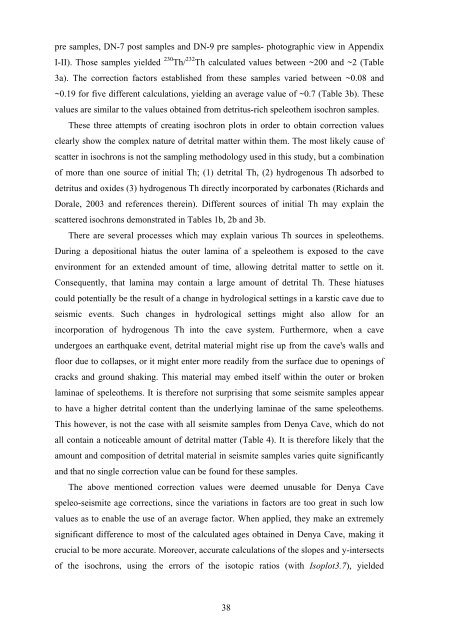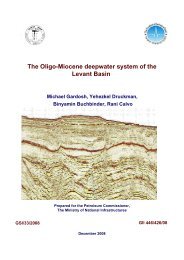tivity on the carmel faul
tivity on the carmel faul
tivity on the carmel faul
You also want an ePaper? Increase the reach of your titles
YUMPU automatically turns print PDFs into web optimized ePapers that Google loves.
pre samples, DN-7 post samples and DN-9 pre samples- photographic view in Appendix<br />
I-II). Those samples yielded 230 Th/ 232 Th calculated values between ~200 and ~2 (Table<br />
3a). The correcti<strong>on</strong> factors established from <strong>the</strong>se samples varied between ~0.08 and<br />
~0.19 for five different calculati<strong>on</strong>s, yielding an average value of ~0.7 (Table 3b). These<br />
values are similar to <strong>the</strong> values obtained from detritus-rich speleo<strong>the</strong>m isochr<strong>on</strong> samples.<br />
These three attempts of creating isochr<strong>on</strong> plots in order to obtain correcti<strong>on</strong> values<br />
clearly show <strong>the</strong> complex nature of detrital matter within <strong>the</strong>m. The most likely cause of<br />
scatter in isochr<strong>on</strong>s is not <strong>the</strong> sampling methodology used in this study, but a combinati<strong>on</strong><br />
of more than <strong>on</strong>e source of initial Th; (1) detrital Th, (2) hydrogenous Th adsorbed to<br />
detritus and oxides (3) hydrogenous Th directly incorporated by carb<strong>on</strong>ates (Richards and<br />
Dorale, 2003 and references <strong>the</strong>rein). Different sources of initial Th may explain <strong>the</strong><br />
scattered isochr<strong>on</strong>s dem<strong>on</strong>strated in Tables 1b, 2b and 3b.<br />
There are several processes which may explain various Th sources in speleo<strong>the</strong>ms.<br />
During a depositi<strong>on</strong>al hiatus <strong>the</strong> outer lamina of a speleo<strong>the</strong>m is exposed to <strong>the</strong> cave<br />
envir<strong>on</strong>ment for an extended amount of time, allowing detrital matter to settle <strong>on</strong> it.<br />
C<strong>on</strong>sequently, that lamina may c<strong>on</strong>tain a large amount of detrital Th. These hiatuses<br />
could potentially be <strong>the</strong> result of a change in hydrological settings in a karstic cave due to<br />
seismic events. Such changes in hydrological settings might also allow for an<br />
incorporati<strong>on</strong> of hydrogenous Th into <strong>the</strong> cave system. Fur<strong>the</strong>rmore, when a cave<br />
undergoes an earthquake event, detrital material might rise up from <strong>the</strong> cave's walls and<br />
floor due to collapses, or it might enter more readily from <strong>the</strong> surface due to openings of<br />
cracks and ground shaking. This material may embed itself within <strong>the</strong> outer or broken<br />
laminae of speleo<strong>the</strong>ms. It is <strong>the</strong>refore not surprising that some seismite samples appear<br />
to have a higher detrital c<strong>on</strong>tent than <strong>the</strong> underlying laminae of <strong>the</strong> same speleo<strong>the</strong>ms.<br />
This however, is not <strong>the</strong> case with all seismite samples from Denya Cave, which do not<br />
all c<strong>on</strong>tain a noticeable amount of detrital matter (Table 4). It is <strong>the</strong>refore likely that <strong>the</strong><br />
amount and compositi<strong>on</strong> of detrital material in seismite samples varies quite significantly<br />
and that no single correcti<strong>on</strong> value can be found for <strong>the</strong>se samples.<br />
The above menti<strong>on</strong>ed correcti<strong>on</strong> values were deemed unusable for Denya Cave<br />
speleo-seismite age correcti<strong>on</strong>s, since <strong>the</strong> variati<strong>on</strong>s in factors are too great in such low<br />
values as to enable <strong>the</strong> use of an average factor. When applied, <strong>the</strong>y make an extremely<br />
significant difference to most of <strong>the</strong> calculated ages obtained in Denya Cave, making it<br />
crucial to be more accurate. Moreover, accurate calculati<strong>on</strong>s of <strong>the</strong> slopes and y-intersects<br />
of <strong>the</strong> isochr<strong>on</strong>s, using <strong>the</strong> errors of <strong>the</strong> isotopic ratios (with Isoplot3.7), yielded<br />
38

















